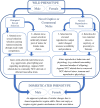Shared reproductive disruption, not neural crest or tameness, explains the domestication syndrome
- PMID: 36946116
- PMCID: PMC10031412
- DOI: 10.1098/rspb.2022.2464
Shared reproductive disruption, not neural crest or tameness, explains the domestication syndrome
Abstract
Altered neural crest cell (NCC) behaviour is an increasingly cited explanation for the domestication syndrome in animals. However, recent authors have questioned this explanation, while others cast doubt on whether domestication syndrome even exists. Here, we review published literature concerning this syndrome and the NCC hypothesis, together with recent critiques of both. We synthesize these contributions and propose a novel interpretation, arguing shared trait changes under ancient domestication resulted primarily from shared disruption of wild reproductive regimes. We detail four primary selective pathways for 'reproductive disruption' under domestication and contrast these succinct and demonstrable mechanisms with cryptic genetic associations posited by the NCC hypothesis. In support of our perspective, we illustrate numerous important ways in which NCCs contribute to vertebrate reproductive phenotypes, and argue it is not surprising that features derived from these cells would be coincidentally altered under major selective regime changes, as occur in domestication. We then illustrate several pertinent examples of Darwin's 'unconscious selection' in action, and compare applied selection and phenotypic responses in each case. Lastly, we explore the ramifications of reproductive disruption for wider evolutionary discourse, including links to wild 'self-domestication' and 'island effect', and discuss outstanding questions.
Keywords: animal domestication; island effect; neural crest cell hypothesis; self-domestication; unconscious selection.
Conflict of interest statement
We declare we have no competing interests.
Figures
References
-
- Le Douarin NM, Kalcheim C. 1999. The neural crest. Cambridge, UK: Cambridge University Press.
Publication types
MeSH terms
LinkOut - more resources
Full Text Sources
Miscellaneous

